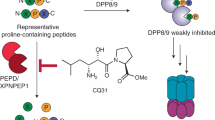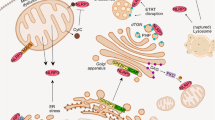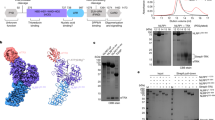Abstract
Formation of the inflammasome, a scaffolding complex that activates caspase-1, is important in numerous diseases. Pyroptotic cell death induced by anthrax lethal toxin (LT) is a model for inflammasome-mediated caspase-1 activation. We discovered 7-desacetoxy-6,7-dehydrogedunin (7DG) in a phenotypic screen as a small molecule that protects macrophages from LT-induced death. Using chemical proteomics, we identified protein kinase R (PKR) as the target of 7DG and show that RNAi knockdown of PKR phenocopies treatment with 7DG. Further, we show that PKR's role in ASC assembly and caspase-1 activation induced by several different inflammasome stimuli is independent of PKR's kinase activity, demonstrating that PKR has a previously uncharacterized role in caspase-1 activation and pyroptosis that is distinct from its reported kinase-dependent roles in apoptosis and inflammasome formation in lipopolysaccharide-primed cells. Remarkably, PKR has different roles in two distinct cell death pathways and has a broad role in inflammasome function relevant in other diseases.
This is a preview of subscription content, access via your institution
Access options
Subscribe to this journal
Receive 12 print issues and online access
$259.00 per year
only $21.58 per issue
Buy this article
- Purchase on Springer Link
- Instant access to full article PDF
Prices may be subject to local taxes which are calculated during checkout






Similar content being viewed by others
Change history
21 May 2013
In the print version of this article, two labels were omitted from the graphical abstract on the Table of Contents page. The error has been corrected in the HTML and PDF versions of the Table of Contents.
References
Collier, R.J. & Young, J.A. Anthrax toxin. Annu. Rev. Cell Dev. Biol. 19, 45–70 (2003).
Ascenzi, P. et al. Anthrax toxin: a tripartite lethal combination. FEBS Lett. 531, 384–388 (2002).
Menu, P. & Vince, J.E. The NLRP3 inflammasome in health and disease: the good, the bad and the ugly. Clin. Exp. Immunol. 166, 1–15 (2011).
Duesbery, N.S. et al. Proteolytic inactivation of MAP-kinase-kinase by anthrax lethal factor. Science 280, 734–737 (1998).
Friedlander, A.M. Macrophages are sensitive to anthrax lethal toxin through an acid-dependent process. J. Biol. Chem. 261, 7123–7126 (1986).
Agrawal, A. & Pulendran, B. Anthrax lethal toxin: a weapon of multisystem destruction. Cell Mol. Life Sci. 61, 2859–2865 (2004).
Newman, Z.L. et al. Susceptibility to anthrax lethal toxin–induced rat death is controlled by a single chromosome 10 locus that includes rNlrp1. PLoS Pathog. 6, e1000906 (2010).
Beall, F.A. & Dalldorf, F.G. The pathogenesis of the lethal effect of anthrax toxin in the rat. J. Infect. Dis. 116, 377–389 (1966).
Terra, J.K. et al. Cutting edge: resistance to Bacillus anthracis infection mediated by a lethal toxin sensitive allele of Nalp1b/Nlrp1b. J. Immunol. 184, 17–20 (2010).
Boyden, E.D. & Dietrich, W.F. Nalp1b controls mouse macrophage susceptibility to anthrax lethal toxin. Nat. Genet. 38, 240–244 (2006).
Cordoba-Rodriguez, R., Fang, H., Lankford, C.S. & Frucht, D.M. Anthrax lethal toxin rapidly activates caspase-1/ICE and induces extracellular release of interleukin (IL)-1β and IL-18. J. Biol. Chem. 279, 20563–20566 (2004).
Tang, G. & Leppla, S.H. Proteasome activity is required for anthrax lethal toxin to kill macrophages. Infect. Immun. 67, 3055–3060 (1999).
Levinsohn, J.L. et al. Anthrax lethal factor cleavage of Nlrp1 is required for activation of the inflammasome. PLoS Pathog. 8, e1002638 (2012).
Lu, B. et al. Novel role of PKR in inflammasome activation and HMGB1 release. Nature 488, 670–674 (2012).
Wickliffe, K.E., Leppla, S.H. & Moayeri, M. Anthrax lethal toxin–induced inflammasome formation and caspase-1 activation are late events dependent on ion fluxes and the proteasome. Cell Microbiol. 10, 332–343 (2008).
Park, J.M., Greten, F.R., Li, Z.W. & Karin, M. Macrophage apoptosis by anthrax lethal factor through p38 MAP kinase inhibition. Science 297, 2048–2051 (2002).
Hsu, L.C. et al. The protein kinase PKR is required for macrophage apoptosis after activation of Toll-like receptor 4. Nature 428, 341–345 (2004).
Hanna, P.C., Acosta, D. & Collier, R.J. On the role of macrophages in anthrax. Proc. Natl. Acad. Sci. USA 90, 10198–10201 (1993).
Moayeri, M., Sastalla, I. & Leppla, S.H. Anthrax and the inflammasome. Microbes Infect. 14, 392–400 (2012).
Moayeri, M., Martinez, N.W., Wiggins, J., Young, H.A. & Leppla, S.H. Mouse susceptibility to anthrax lethal toxin is influenced by genetic factors in addition to those controlling macrophage sensitivity. Infect. Immun. 72, 4439–4447 (2004).
Liu, S. et al. Anthrax toxin targeting of myeloid cells through the CMG2 receptor is essential for establishment of Bacillus anthracis infections in mice. Cell Host Microbe 8, 455–462 (2010).
Newman, Z.L. et al. Susceptibility to anthrax lethal toxin–induced rat death is controlled by a single chromosome 10 locus that includes rNlrp1. PLoS Pathog. 6, e1000906 (2010).
Hornung, V. et al. Silica crystals and aluminum salts activate the NALP3 inflammasome through phagosomal destabilization. Nat. Immunol. 9, 847–856 (2008).
Hornung, V. et al. AIM2 recognizes cytosolic dsDNA and forms a caspase-1–activating inflammasome with ASC. Nature 458, 514–518 (2009).
Panchal, R.G. et al. Chemical genetic screening identifies critical pathways in anthrax lethal toxin-induced pathogenesis. Chem. Biol. 14, 245–255 (2007).
Gaddis, B.D., Avramova, L.V. & Chmielewski, J. Inhibitors of anthrax lethal factor. Bioorg. Med. Chem. Lett. 17, 4575–4578 (2007).
Newman, Z.L. et al. Auranofin protects against anthrax lethal toxin–induced activation of the Nlrp1b inflammasome. Antimicrob. Agents Chemother. 55, 1028–1035 (2011).
Sanchez, A.M. et al. Amiodarone and bepridil inhibit anthrax toxin entry into host cells. Antimicrob. Agents Chemother. 51, 2403–2411 (2007).
Slater, L.H. et al. Identification of novel host-targeted compounds that protect from anthrax lethal toxin-induced cell death. ACS Chem. Biol. 10.1021/cb300555n (4 February 2013).
Lamb, J. et al. The Connectivity Map: using gene-expression signatures to connect small molecules, genes, and disease. Science 313, 1929–1935 (2006).
Thomis, D.C. & Samuel, C.E. Mechanism of interferon action: autoregulation of RNA-dependent P1/eIF-2α protein kinase (PKR) expression in transfected mammalian cells. Proc. Natl. Acad. Sci. USA 89, 10837–10841 (1992).
Jammi, N.V., Whitby, L.R. & Beal, P.A. Small molecule inhibitors of the RNA-dependent protein kinase. Biochem. Biophys. Res. Commun. 308, 50–57 (2003).
García, M.A. et al. Impact of protein kinase PKR in cell biology: from antiviral to antiproliferative action. Microbiol. Mol. Biol. Rev. 70, 1032–1060 (2006).
Kumar, A., Haque, J., Lacoste, J., Hiscott, J. & Williams, B.R. Double-stranded RNA-dependent protein kinase activates transcription factor NF-κB by phosphorylating IκB. Proc. Natl. Acad. Sci. USA 91, 6288–6292 (1994).
Kalai, M. et al. The caspase-generated fragments of PKR cooperate to activate full-length PKR and inhibit translation. Cell Death Differ. 14, 1050–1059 (2007).
Bonnet, M.C., Weil, R., Dam, E., Hovanessian, A.G. & Meurs, E.F. PKR stimulates NF-κB irrespective of its kinase function by interacting with the IκB kinase complex. Mol. Cell Biol. 20, 4532–4542 (2000).
Ishii, T., Kwon, H., Hiscott, J., Mosialos, G. & Koromilas, A.E. Activation of the IκB alpha kinase (IKK) complex by double-stranded RNA-binding defective and catalytic inactive mutants of the interferon-inducible protein kinase PKR. Oncogene 20, 1900–1912 (2001).
Bonnet, M.C., Daurat, C., Ottone, C. & Meurs, E.F. The N-terminus of PKR is responsible for the activation of the NF-κB signaling pathway by interacting with the IKK complex. Cell Signal. 18, 1865–1875 (2006).
Liang, X., Gao, C.F., Rutherford, M.S. & Ji, Y. Activation of NF-κB pathway and TNF-α are involved in the cytotoxicity of anthrax lethal toxin in bovine BoMac macrophages. Vet. Microbiol. 146, 111–117 (2010).
Alileche, A., Squires, R.C., Muehlbauer, S.M., Lisanti, M.P. & Brojatsch, J. Mitochondrial impairment is a critical event in anthrax lethal toxin–induced cytolysis of murine macrophages. Cell Cycle 5, 100–106 (2006).
Mariathasan, S. et al. Cryopyrin activates the inflammasome in response to toxins and ATP. Nature 440, 228–232 (2006).
Bauernfeind, F.G. et al. Cutting edge: NF-κB activating pattern recognition and cytokine receptors license NLRP3 inflammasome activation by regulating NLRP3 expression. J. Immunol. 183, 787–791 (2009).
Kaufman, R.J. Double-stranded RNA-activated protein kinase mediates virus-induced apoptosis: a new role for an old actor. Proc. Natl. Acad. Sci. USA 96, 11693–11695 (1999).
Wek, R.C. eIF-2 kinases: regulators of general and gene-specific translation initiation. Trends Biochem. Sci. 19, 491–496 (1994).
He, Y., Franchi, L. & Nunez, G. The protein kinase PKR is critical for LPS-induced iNOS production but dispensable for inflammasome activation in macrophages. Eur. J. Immunol. (2013).
Qiao, Y., Wang, P., Qi, J., Zhang, L. & Gao, C. TLR-induced NF-κB activation regulates NLRP3 expression in murine macrophages. FEBS Lett. 586, 1022–1026 (2012).
Acknowledgements
We would like to thank J. Collier, S. Chiang, B. Kraybill, L. Whitesell, S. Lindquist, S. Santagata, S. Patel-Hett, R. King, N. Dimova, D. Patel and R. Avraham-Atzil for helpful discussions; V. Gelev (Department of Biological Chemistry and Molecular Pharmacology, Harvard Medical School) for PKR constructs and for a valiant attempt to solve the structure of PKR with 7DG; A. Clatworthy for experimental help and discussions; A. Barker for help with production and purification of protective antigen and lethal factor; Y. Wang for help with chemistry; J. Lee for technical assistance; H. Aktas for PKR constructs (Laboratory for Translational Research, Harvard Medical School); A. Barczak for assistance with C57Bl/6 macrophages and discussions; and the Broad Institute chemical screening platform for technical help. We thank E. Fava, P. Denner and A. Kitanovic from the laboratory automation laboratory at the German Center for Neurodegenerative Diseases for the analysis of the ASC speck assays. E.C.H. was funded by an US National Institutes of Health (NIH) National Research Service Award fellowship F32AI084323. This work was supported in part by NIH U54 AI057159 to the New England Center of Excellence–Biodefense and Emerging Infectious Diseases (to D.T.H.).
Author information
Authors and Affiliations
Contributions
E.C.H. prepared the manuscript, designed and conducted experiments; L.H.S., K.G.M., B.G.M., A.S. and E.L. designed and conducted experiments; T.K. designed and synthesized compounds; and D.T.H. prepared the manuscript and designed experiments.
Corresponding authors
Ethics declarations
Competing interests
E.C.H. is currently employed by Pfizer Inc., which develops therapies for immunological diseases.
Supplementary information
Supplementary Text and Figures
Supplementary Results (PDF 3091 kb)
Rights and permissions
About this article
Cite this article
Hett, E., Slater, L., Mark, K. et al. Chemical genetics reveals a kinase-independent role for protein kinase R in pyroptosis. Nat Chem Biol 9, 398–405 (2013). https://doi.org/10.1038/nchembio.1236
Received:
Accepted:
Published:
Issue Date:
DOI: https://doi.org/10.1038/nchembio.1236
This article is cited by
-
Relevant mediators involved in and therapies targeting the inflammatory response induced by activation of the NLRP3 inflammasome in ischemic stroke
Journal of Neuroinflammation (2021)
-
Molecular insights into the therapeutic promise of targeting HMGB1 in depression
Pharmacological Reports (2021)
-
Connexin 43 Hemichannel as a Novel Mediator of Sterile and Infectious Inflammatory Diseases
Scientific Reports (2018)
-
Post-translational regulation of inflammasomes
Cellular & Molecular Immunology (2017)
-
Inflammation, metaflammation and immunometabolic disorders
Nature (2017)



